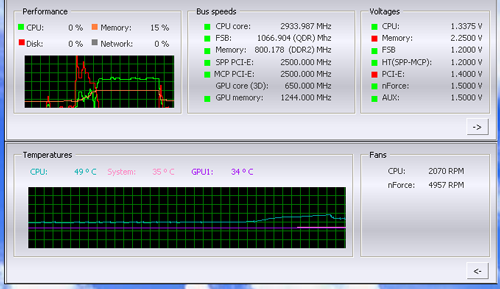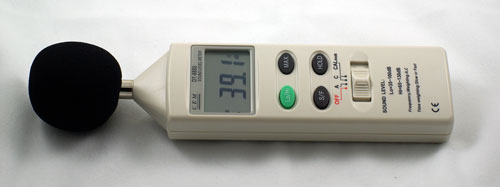Value Cooling: Two Towers for under $30
by Wesley Fink on January 23, 2007 3:50 AM EST- Posted in
- Cases/Cooling/PSUs
CPU Cooling Test Configuration
A requirement for any cooling test bed is a reliable utility for measuring CPU temperature and fan speed. The utility also must be usable while other programs are running so the impact of stress testing can be assessed. After evaluating a number of Intel 975/965 and NVIDIA 680i motherboards the decision was reached to use the NVIDIA 680i as the cooling test bed. This was primarily based on the excellent temperature measurement utility, NVIDIA Monitor, which is part of the nTune program.

NVIDIA Monitor has a drop-down pane for temperature measurement which reports CPU, System, and GPU measurement. At this point we will concentrate primarily on CPU temperature with listings of system temps for reference. In addition to the real-time temperature measurement, NVIDIA Monitor also has a logging feature which can record temperature in a file in standard increments (we selected every 4 seconds). This allows recording of temperatures during testing and play back, for example, of stress test results that can then be examined when the stress tests are completed. There is also the handy reference of speeds and voltages in the top pane to confirm the test setup.
Other components in the cooling test bed are generally the same as those used in our motherboard and memory test bed:
We first tested the stock Intel cooler at standard X6800 speed, measuring the CPU temperature at idle and while the CPU was being stressed. We stressed the CPU by running continuous loops of the Far Cry River demo. The same tests were repeated at the highest stable overclock we could achieve with the stock cooler. Stable in this case meant the ability to handle our Far Cry looping for at least 30 minutes.
The same tests were then run on the cooler under test at stock, highest stock cooler OC speed (3.73GHz), and the highest OC that could be achieved in the same setup with the cooler being tested. This allows measurement of the cooling efficiency of the test unit compared to stock and the improvement in overclocking capabilities, if any, from using the test cooler.
Noise Levels

In addition to cooling efficiency and overclocking abilities, users shopping for CPU cooling solutions may also be interested in the noise levels of the cooling devices they are considering. Noise levels are measured using a C. E. M. DT-8850 Sound Level meter. This meter allows accurate sound level measurements from 35bdB to 130dB with a resolution of 0.1dB and an accuracy of 1.5dB. This is sufficient for our needs in these tests, as measurement starts at the level of a relatively quiet room. Our own test room, with all computers and fans turned off, has a room noise level of 36.4dB.
Our procedures for measuring cooling system noise are described on page 6 along with noise results comparing the stock Intel cooler to the tested coolers.
A requirement for any cooling test bed is a reliable utility for measuring CPU temperature and fan speed. The utility also must be usable while other programs are running so the impact of stress testing can be assessed. After evaluating a number of Intel 975/965 and NVIDIA 680i motherboards the decision was reached to use the NVIDIA 680i as the cooling test bed. This was primarily based on the excellent temperature measurement utility, NVIDIA Monitor, which is part of the nTune program.

NVIDIA Monitor has a drop-down pane for temperature measurement which reports CPU, System, and GPU measurement. At this point we will concentrate primarily on CPU temperature with listings of system temps for reference. In addition to the real-time temperature measurement, NVIDIA Monitor also has a logging feature which can record temperature in a file in standard increments (we selected every 4 seconds). This allows recording of temperatures during testing and play back, for example, of stress test results that can then be examined when the stress tests are completed. There is also the handy reference of speeds and voltages in the top pane to confirm the test setup.
Other components in the cooling test bed are generally the same as those used in our motherboard and memory test bed:
| Cooling Performance Test Configuration | |
| Processor: | Intel Core 2 Duo X6800 (x2, 2.93GHz, 4MB Unified Cache) |
| RAM: | 2x1GB Corsair Dominator PC2-8888 (DDR2-1111) |
| Hard Drive: | Hitachi 250GB SATA2 enabled (16MB Buffer) |
| Video Card: | 1 x EVGA 7900GTX - All Standard Tests |
| Platform Drivers: | NVIDIA 9.53 |
| NVIDIA nTune: | 5.05.22.00 (1/16/2007) |
| Video Drivers: | NVIDIA 93.71 |
| CPU Cooling: | Thermalright MST-9775 Scythe Katana Tuniq Tower 120 Intel Stock HSF for X6800 |
| Power Supply: | OCZ PowerStream 520W |
| Motherboards: | EVGA nForce 680i SLI (NVIDIA 680i) |
| Operating System: | Windows XP Professional SP2 |
| BIOS: | Award P24 (1/12/2007) |
We first tested the stock Intel cooler at standard X6800 speed, measuring the CPU temperature at idle and while the CPU was being stressed. We stressed the CPU by running continuous loops of the Far Cry River demo. The same tests were repeated at the highest stable overclock we could achieve with the stock cooler. Stable in this case meant the ability to handle our Far Cry looping for at least 30 minutes.
| X6800 CPU Operating Temperature Standard Intel Heatsink/Fan (Ambient Temperature 21C (70F) |
||
| CPU | System | |
| IDLE 2.93GHz | 41C (106F) | 32C (90F) |
| STRESS 2.93GHz | 56C (133F) | 33C (91F) |
| IDLE 3.73GHz | 56C (133F) | 37C (99F) |
| STRESS 3.73GHz | 71C (160F) | 38C (100F) |
The same tests were then run on the cooler under test at stock, highest stock cooler OC speed (3.73GHz), and the highest OC that could be achieved in the same setup with the cooler being tested. This allows measurement of the cooling efficiency of the test unit compared to stock and the improvement in overclocking capabilities, if any, from using the test cooler.
Noise Levels

In addition to cooling efficiency and overclocking abilities, users shopping for CPU cooling solutions may also be interested in the noise levels of the cooling devices they are considering. Noise levels are measured using a C. E. M. DT-8850 Sound Level meter. This meter allows accurate sound level measurements from 35bdB to 130dB with a resolution of 0.1dB and an accuracy of 1.5dB. This is sufficient for our needs in these tests, as measurement starts at the level of a relatively quiet room. Our own test room, with all computers and fans turned off, has a room noise level of 36.4dB.
Our procedures for measuring cooling system noise are described on page 6 along with noise results comparing the stock Intel cooler to the tested coolers.










28 Comments
View All Comments
orangesky - Tuesday, January 23, 2007 - link
Since the Thermalright fan blows down towards the motherboard (as does Intel's stock HSF), but the Katana blows across (and out of the case), it seems like there would be a noticable air flow difference on the components around the CPU (e.g., VRM, memory, and NB).Was there any difference noted in the temperature of the "motherboard" (which probably is the NB)? I'm wondering if this is a concern or not, especially for OC'ing?
Spacecomber - Tuesday, January 23, 2007 - link
For coolers, like the Katana, which lack 4-wire connectors that 775 motherboards can automatically adjust fan speeds via, perhaps it would be helpful to take advantage of speedfan for comparing cooling across a range of fan speeds. (This is assuming that the relatively new 680i motherboard that you are using is supported by SpeedFan.)Doh! - Tuesday, January 23, 2007 - link
A new version of Katana has a 4-wire connector. I just bought one last week. The box has 775 written on it and does not come with a back plate.Wesley Fink - Tuesday, January 23, 2007 - link
Scythe has introduced another version of the Katana called the Katana 775. This was to address the installation and fan speed issues we discussed. The Katana 775 only fits Socket 775 and it comes with a 4-pin fan header. The original Katana, with universal installation as we reviewed here, continues as a current product.If you are only concerned with Socket 775 the Scythe Katana 775 looks lik a much better choice with easier installation and fan speed control at the same price or less than the original Katana.
KorruptioN - Tuesday, January 23, 2007 - link
For under $30, I think the Arctic Cooling Freezer 7 Pro should've been included. Quiet, not so heavy, with very good performance for the money.Wesley Fink - Tuesday, January 23, 2007 - link
We are not finished with coolers under $30, and we will try to include the Arctic Cooling Freezer 7 Pro in our upcoming value cooler roundup. The Freezer 7 Pro also uses a 92mm fan, but it weighs a bit more than this pair at 520g (vs. 300g and 420g).mostlyprudent - Tuesday, January 23, 2007 - link
I notice in the noise charts that the Retail HSF is only listed once. Is this at its idle speed? I may have missed it in the review, but what is the RPM range of the retail HSF?BTW, nice article.
Wesley Fink - Tuesday, January 23, 2007 - link
The Intel Retail HSF was below the system noise floor at both high and low speeds. We will try to make this clearer in future reviews.